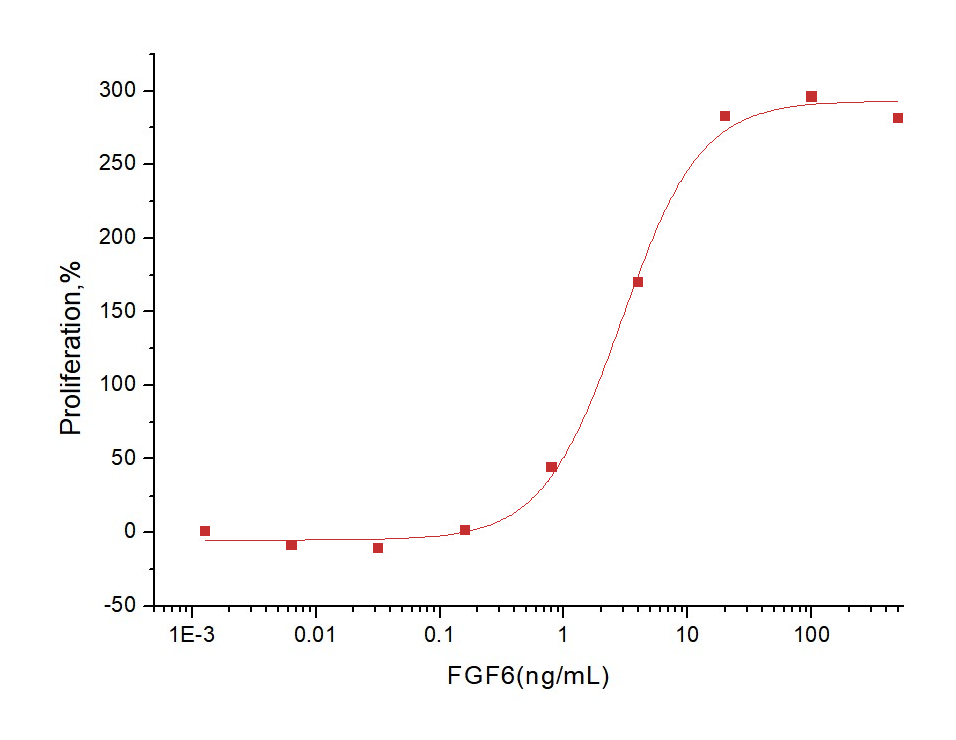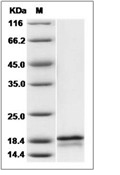Shopping Cart
- Remove All
 Your shopping cart is currently empty
Your shopping cart is currently empty

FGF6, also known as FGF-6, belongs to the fibroblast growth factor (FGF) family. Members of this family possess broad mitogenic and cell survival activities, and are involved in a variety of biological processes, including embryonic development, cell growth, morphogenesis, tissue repair, tumor growth and invasion. FGF6 plays an important role in the regulation of cell proliferation, cell differentiation, angiogenesis and myogenesis. It is also required for normal muscle regeneration. FGF6 gene displayed oncogenic transforming activity when transfected into mammalian cells.

| Pack Size | Price | Availability | Quantity |
|---|---|---|---|
| 20 μg | $106 | In Stock | |
| 100 μg | $397 | 7-10 days | |
| 200 μg | $700 | 7-10 days | |
| 500 μg | $1,480 | 7-10 days |
| Biological Activity | Measured in a cell proliferation assay using BALB/c 3T3 mouse fibroblasts. The ED50 for this effect is typically 1-6 ng/mL.  |
| Description | FGF6, also known as FGF-6, belongs to the fibroblast growth factor (FGF) family. Members of this family possess broad mitogenic and cell survival activities, and are involved in a variety of biological processes, including embryonic development, cell growth, morphogenesis, tissue repair, tumor growth and invasion. FGF6 plays an important role in the regulation of cell proliferation, cell differentiation, angiogenesis and myogenesis. It is also required for normal muscle regeneration. FGF6 gene displayed oncogenic transforming activity when transfected into mammalian cells. |
| Species | Human |
| Expression System | E. coli |
| Tag | Tag Free |
| Accession Number | P10767 |
| Synonyms | HST2,HBGF-6,fibroblast growth factor 6 |
| Construction | A DNA sequence encoding the mature form of human FGF6 (NP_066276.2)(Gly41-Ile208) was expressed with a N-terminal Met. Predicted N terminal: Met |
| Protein Purity | > 95 % as determined by SDS-PAGE  |
| Molecular Weight | 18.9 kDa (predicted); 19 kDa (reducing conditions) |
| Endotoxin | Please contact us for more information. |
| Formulation | Lyophilized from a solution filtered through a 0.22 μm filter, containing PBS pH 7.4. Typically, a mixture containing 5% to 8% trehalose, mannitol, and 0.01% Tween 80 is incorporated as a protective agent before lyophilization. |
| Reconstitution | A Certificate of Analysis (CoA) containing reconstitution instructions is included with the products. Please refer to the CoA for detailed information. |
| Stability & Storage | It is recommended to store recombinant proteins at -20°C to -80°C for future use. Lyophilized powders can be stably stored for over 12 months, while liquid products can be stored for 6-12 months at -80°C. For reconstituted protein solutions, the solution can be stored at -20°C to -80°C for at least 3 months. Please avoid multiple freeze-thaw cycles and store products in aliquots. |
| Shipping | In general, Lyophilized powders are shipping with blue ice. |
| Research Background | FGF6, also known as FGF-6, belongs to the fibroblast growth factor (FGF) family. Members of this family possess broad mitogenic and cell survival activities, and are involved in a variety of biological processes, including embryonic development, cell growth, morphogenesis, tissue repair, tumor growth and invasion. FGF6 plays an important role in the regulation of cell proliferation, cell differentiation, angiogenesis and myogenesis. It is also required for normal muscle regeneration. FGF6 gene displayed oncogenic transforming activity when transfected into mammalian cells. |

Copyright © 2015-2025 TargetMol Chemicals Inc. All Rights Reserved.